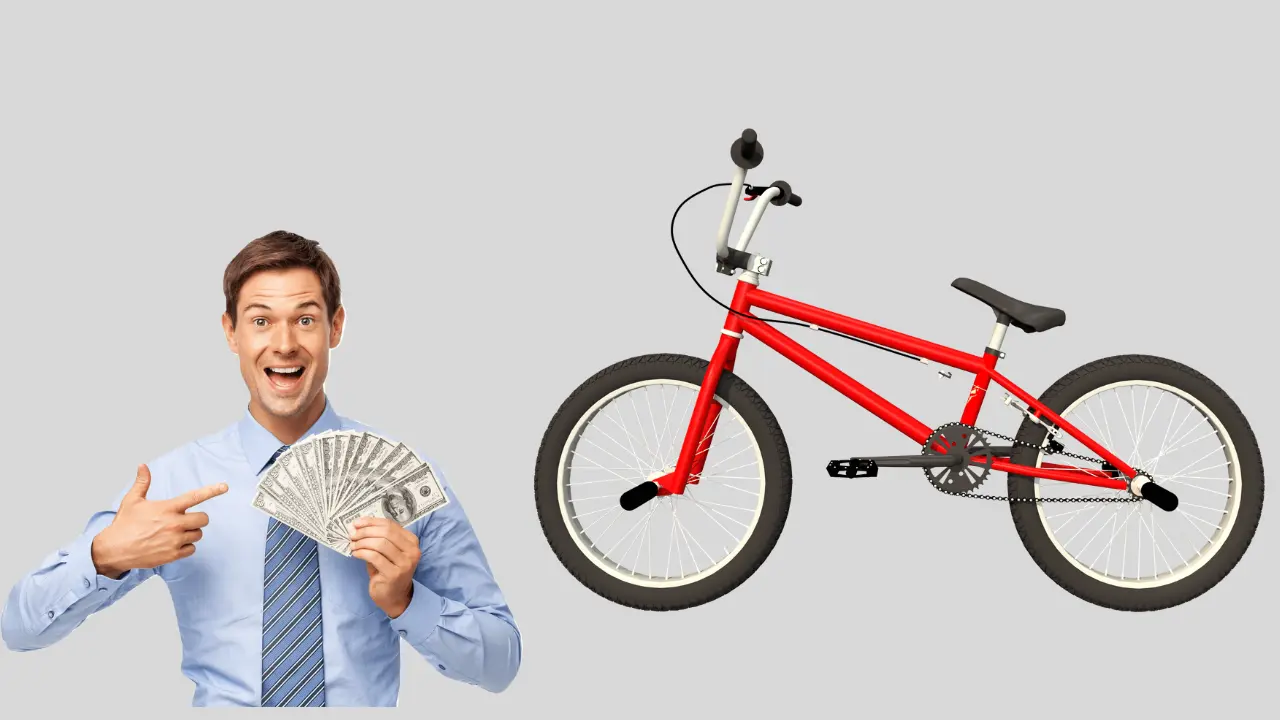"As an Amazon Associate, I earn from qualifying purchases. This post contains affiliate links"
If you are just stepping into the amazing world of BMX and looking to discover the prices of the BMX bikes, you have come to the right place.
I know you should be looking for bikes in the market, but that sounds cumbersome, and you don’t feel like doing it. Don’t worry; I have already done your research, so you don’t need to go anywhere now.
So how much does a BMX bike cost on average?
The price of BMX bikes ranges depending on the manufacturer of the bike, the place where you are buying it from, and the bike features. On average, a BMX bike costs around $200 to $1500. Even some bikes are available for $250 to $300.
So you see, there is no concrete range of BMX bike prices. But how would you know whether a bike is worth that much money? Some factors can help you minimize your search space but also help you select the right bike at a reasonable price.
Factors Affecting BMX Bike Prices

Here are some common factors that affect the prices of BMX bikes. These will indeed decide how much a BMX bike is worth.
Frame Materials And Construction
BMX bikes with high-tensile steel frames are generally more affordable than other materials. High-tensile steel is durable but heavier, affecting the bike’s performance and maneuverability.
Chromoly frames are made from a high-strength steel alloy called chromium-molybdenum. These frames are lighter, stronger, and more responsive than high-tensile steel frames. BMX bikes with chromoly frames tend to be priced higher due to the superior material quality.
Aluminum frames offer a lightweight option for BMX bikes. They provide an excellent strength-to-weight ratio, allowing for improved agility and speed. BMX bikes with aluminum frames are usually priced higher due to the higher manufacturing costs of aluminum.
The most expensive option in BMX bikes is carbon fiber frames. Carbon fiber offers exceptional strength, stiffness, and lightness. These frames are commonly found in high-end, professional-grade BMX bikes with a premium price tag.
Components And Accessories
Additionally, components and accessories also vary in price ranges, ultimately adding to the bike’s total cost.
For instance:
- Forks: Forks are essential to the BMX bike’s front suspension system. The forks’ material, design, and quality can impact the bike’s performance and durability. Higher-priced BMX bikes often feature high-quality, lightweight forks made from chromoly or carbon fiber.
- Handlebars: BMX handlebars come in various materials, shapes, and sizes. The choice of handlebars can affect the rider’s comfort, control, and riding style. High-end BMX bikes may include handlebars made from lightweight materials like chromoly or aluminum alloy, with additional features such as increased strength and ergonomic designs.
- Cranks and Brackets: The cranks and bottom brackets connect the pedals to the frame and play a crucial role in power transfer and pedaling efficiency. BMX bikes with higher-priced components tend to have cranks and bottom brackets made from more substantial materials like chromoly or aluminum, offering improved performance and durability.
- Wheels and Tires: The wheels’ and tires’ quality and construction can significantly influence a BMX bike’s performance. High-end BMX bikes often feature lighter, more durable wheelsets with sealed bearings for reduced friction. Similarly, premium tires with advanced tread patterns and higher-quality rubber are more common in expensive BMX bikes.
- Brakes: BMX bikes can have different brake setups, including calipers, U-brakes, or disc brakes. The quality and effectiveness of the brakes, as well as the presence of additional features such as adjustable brake levers, can contribute to the overall price of the bike.
- Pedals: Pedals play a crucial role in grip and control while riding. High-quality pedals made from durable materials like aluminum or magnesium alloy, with additional features such as sealed bearings or replaceable pins, can increase the price of a BMX bike.
- Seat: The seat and seat post contribute to rider comfort and adjustability. More expensive BMX bikes often have seats and seat posts with better materials, padding, and adjustable features to cater to individual rider preferences.
Last, the gearing system determines the bike’s gear ratios, affecting acceleration, top speed, and ease of pedaling. BMX bikes may feature single-speed or multi-speed gearing systems.
Bikes with higher-priced gearing systems often provide smoother shifting, more precise gear ratios, and lightweight components.
Brand Reputation And Quality

Established vs. lesser-known brands: the brand reputation and market presence can influence BMX bike prices. Established brands with a long history of producing high-quality BMX bikes tend to command higher prices due to their reputation and customer trust.
Reputation for durability and performance: BMX bikes from brands known for their durability, performance, and innovation often have higher price tags. These brands invest in research, development, and quality control to provide riders with reliable, high-performing bikes.
Pro rider endorsements: BMX bikes endorsed by professional riders or associated with successful teams can have higher prices due to the marketing value and perceived performance benefits related to the endorsement.
Bike Type And Purpose
BMX bikes designed for freestyle ridings, such as performing tricks and stunts in skateparks or street environments, can vary in price depending on the specific features required for this type of riding.
Racing BMX bikes are built for speed and agility on racetracks. These bikes often have lightweight frames, specialized components, and aerodynamic designs. Racing BMX bikes can be more expensive due to the focus on performance-enhancing features.
Street/Park BMX bikes, including ramps, rails, and other street obstacles, are designed for urban riding. The price of these bikes can vary depending on the durability, strength, and versatility required for these demanding riding conditions.
Dirt BMX bikes are built for off-road jumps and dirt tracks. These bikes typically have more robust frames, larger tires, and components to withstand the impact and forces encountered during dirt riding. The price of dirt BMX bikes may reflect the extra durability and specialized features needed for this type of riding.
Customization And Aftermarket Upgrades
BMX riders often personalize their bikes with custom components, colors, and accessories. While these customizations can add to the bike’s overall cost, they allow riders to tailor it to their preferences and style.
BMX bikes can be upgraded with aftermarket components, such as higher-quality parts or specialized accessories. The ability to upgrade and enhance the bike’s performance and features over time may be a consideration for riders, contributing to the overall investment in the cycle.
How Much Should I Spend On A Bmx Bike?

The amount you should spend on a BMX bike depends on various factors, including your budget, riding goals, skill level, and personal preferences. Generally, BMX bikes range in price from around $200 to over $2000.
If you’re a beginner or casual rider, finding a decent entry-level BMX bike in the $200 to $500 price range is possible. These bikes usually offer essential components and materials suitable for learning and recreational riding.
For intermediate riders more dedicated to the sport and seeking better performance, investing in a mid-range BMX bike in the $500 to $1000 range may be a good option. These bikes often have higher-quality components, improved frame materials, and better durability.
If you’re an experienced or professional rider or looking for top-of-the-line features and the latest technologies, high-end BMX bikes priced over $1000 may be more suitable. These bikes are often lighter and more robust and incorporate premium materials and advanced components for optimal performance.
It’s essential to consider your riding style, preferences, and intended use of the bike when determining your budget. Investing in a higher-quality bike can provide better durability, performance, and overall riding experience in the long run.
Is BMX Cheaper Than MTB?
In general, BMX bikes tend to be cheaper than mountain bikes (MTBs). There are several reasons for this price difference:
Complexity and Components: Mountain bikes are typically more complex in design and require a wider range of components, such as suspension systems, multiple gears, and specialized braking systems. These additional components and technologies contribute to the higher cost of manufacturing and assembling mountain bikes.
Materials: Mountain bikes often utilize more advanced materials, such as lightweight aluminum or carbon fiber frames, to provide strength, durability, and enhanced performance on rough terrains. These materials tend to be more expensive than those used in BMX bikes, such as steel or lower-grade aluminum.
Specialized Features: Mountain bikes may have specialized features like full suspension or advanced shock absorption systems to handle rough trails and off-road conditions. These features add to the overall cost of the bike.
Market Demand: The market demand for mountain bikes is generally higher than that of BMX bikes, which can influence pricing. Mountain bikes cater to a broader range of riders and have a wider application, including recreational trail riding, cross-country racing, downhill racing, and more. The larger market and higher demand contribute to the pricing of mountain bikes.
While BMX bikes are typically more affordable, it’s important to note that there is still a wide range of prices within both BMX and mountain bike categories. The specific features, materials, brand reputation, and the bike’s intended use can all affect the price.
It’s recommended to consider your riding goals, preferences, and budget to determine which type of bike suits your needs best.
Final Thoughts!
So how much does a BMX bike cost?
As mentioned earlier, the cost of a BMX bike can vary significantly depending on factors such as the brand, frame materials, components, bike type, and customization options.
Entry-level BMX bikes range from around $200 to $500, offering basic features suitable for beginners and casual riders. Mid-range BMX bikes typically fall in the $500 to $1000 and even $2000 price range, providing better quality components and improved performance for intermediate riders.
High-end BMX bikes, priced over $1000, offer advanced features, premium materials, and cutting-edge technologies for experienced or professional riders seeking optimal performance.
It’s important to consider your budget, riding goals, skill level, and personal preferences when determining how much to spend on a BMX bike. Investing in a higher-quality bike can provide better durability, performance, and overall riding experience in the long run.
However, finding affordable options that still offer a satisfactory riding experience for beginners or recreational riders is also possible. I hope you have found this article helpful and interesting. Please don’t forget to share your feedback with me!
Happy riding!
Related Articles:-
- Top Rated Best BMX Pedals: Pedal Perfection
- Can Adults Ride BMX Bikes? Embrace The Ride
- Does BMX Tire Width Matter? Size Isn’t Everything
- Best BMX Bikes For Adults Quality On a Budget

